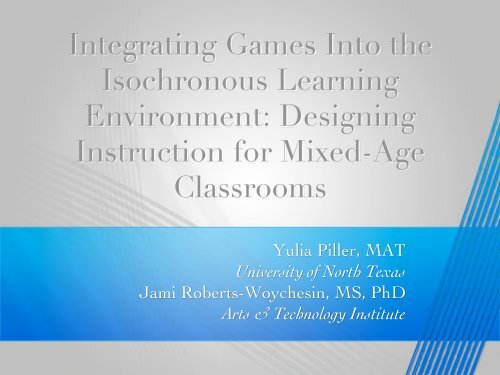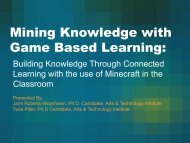Seville Presentation
You also want an ePaper? Increase the reach of your titles
YUMPU automatically turns print PDFs into web optimized ePapers that Google loves.
Integrating Games Into the<br />
Isochronous Learning<br />
Environment: Designing<br />
Instruction for Mixed-Age<br />
Classrooms<br />
Yulia Piller, MAT<br />
University of North Texas<br />
Jami Roberts-Woychesin, MS, PhD<br />
Arts & Technology Institute
Yulia Piller<br />
Jami Roberts-Woychesin
Introduction<br />
We will present the initial stages of development<br />
of the Isochronous Instructional Framework (IIF)<br />
IIF is rooted in ethnographic evidence collected<br />
over a period of 10 months<br />
Courses analyzed included a 12-week course in<br />
computer literacy and four 5-day workshops
Why This?<br />
At Arts and Technology Institute (ATI) classes<br />
are all mixed-age and students start at different<br />
learning levels.<br />
Popularity growth for the mixed-age class model.<br />
Strengthens higher learners while teaching lower<br />
level learners.
Introduction<br />
Case Studies took place in the Dallas, Texas area.<br />
Students ranged in age from 8 yo - 13 yo.<br />
Computer Literacy class contained 20 students<br />
Minecraft Learn to Mod classes = 16 students
Games in the Classroom<br />
Games should afford learners ability to construct<br />
new knowledge.<br />
Pressure to introduce games in the classroom<br />
Problem of disconnect<br />
Problems with existing frameworks
Flow Theory<br />
Successful learning activities establish flow or a<br />
balance between the ability of the student and the<br />
challenge.<br />
Environments are created that maintain flow while<br />
learning objectives are met.<br />
Opportunities for knowledge and transfer are<br />
presented to students.<br />
Vygotsky’s zone of proximal development is used<br />
scaffolding content without flow interruption.
Theoretical Framework<br />
SOLO<br />
Gagne’s Events of Instruction<br />
Bloom’s Taxonomy
SOLO Taxonomy<br />
Breaks down the complexity of learning into five levels<br />
of a student’s understanding.<br />
Serves to guide levels of comprehension that can be<br />
incorporated with the proposed learning results and<br />
make appraisal criteria of rubrics.<br />
Affords the instructor to analyze the students work in<br />
terms of quality.
SOLO
Gagne Events of Instruction<br />
Learners must proceed through a hierarchy of<br />
skills to complex in order to attain certain learning<br />
outcomes.<br />
These include nine events of instruction.<br />
Useful in identifying educational content of a game.
Bloom’s Taxonomy<br />
Cognitive aspect of learning outcomes<br />
Lower level / Higher level thinking skills<br />
Identifies 3 domains of learning:<br />
Cognitive, Affective, & Psychomotor
Introduction to IIF<br />
isochronous -<br />
mathematical term of<br />
isochronous<br />
curve - a cycloid curve<br />
to its finishing point is<br />
independent of the<br />
starting point of each<br />
object,<br />
given that gravity is<br />
uniform and there is no<br />
friction.
IIF<br />
Isochronous Learning Environment<br />
any classroom in which students are of mixed ages<br />
working toward the same learning objective<br />
independent of their initial knowledge and skill<br />
level.<br />
-Uniform gravity = constant flow<br />
-Friction = anything that can be caused by student’s<br />
learning differences, environmental,<br />
logistical, and social difficulties
IIF<br />
Objectives (teaching & learning) drives game<br />
selection.<br />
Properly defined objectives = solid understanding<br />
Iterative Assessment allows progression
Integrating Games into IIF<br />
Games for assessment<br />
e.g. Jeopardy<br />
Games for understanding<br />
e.g. Rube Goldberg machine in Contraption Maker<br />
Games for transfer and application<br />
e.g. Redstone in Minecraft
Conclusion<br />
Set teaching and learning objectives<br />
Constant assessment<br />
Need for further studies




